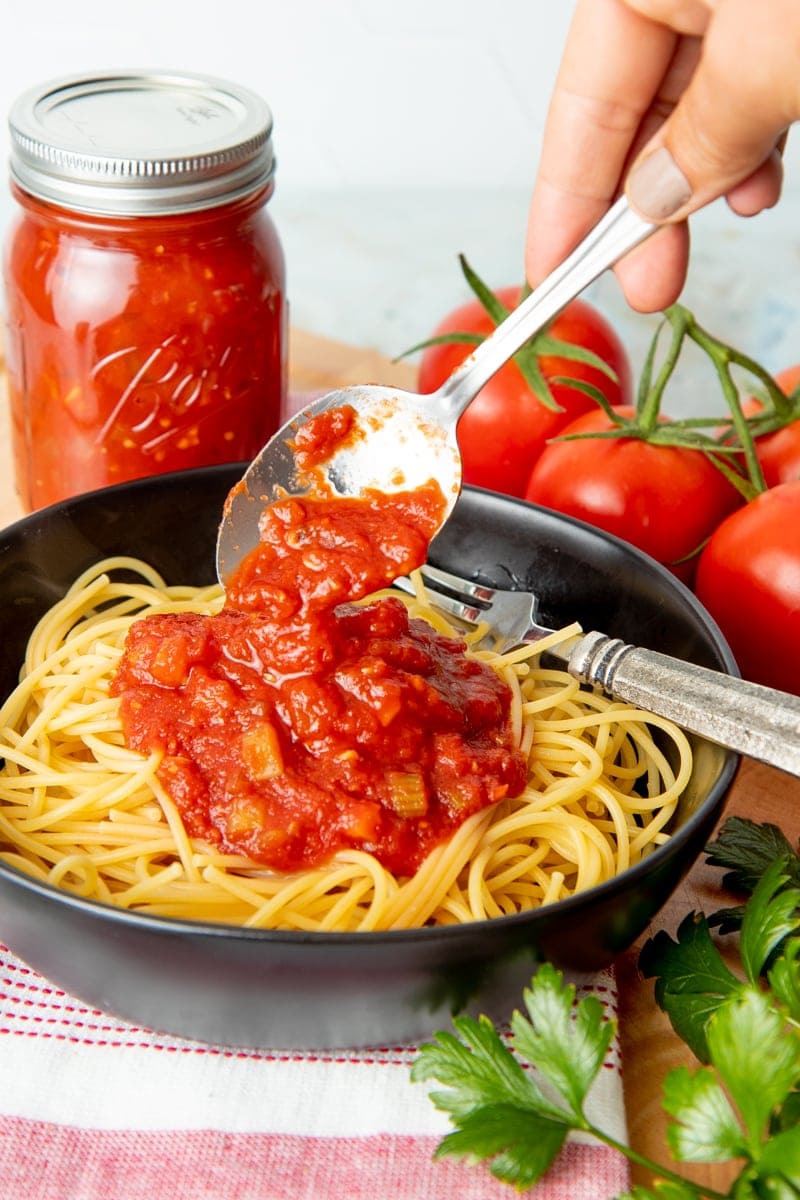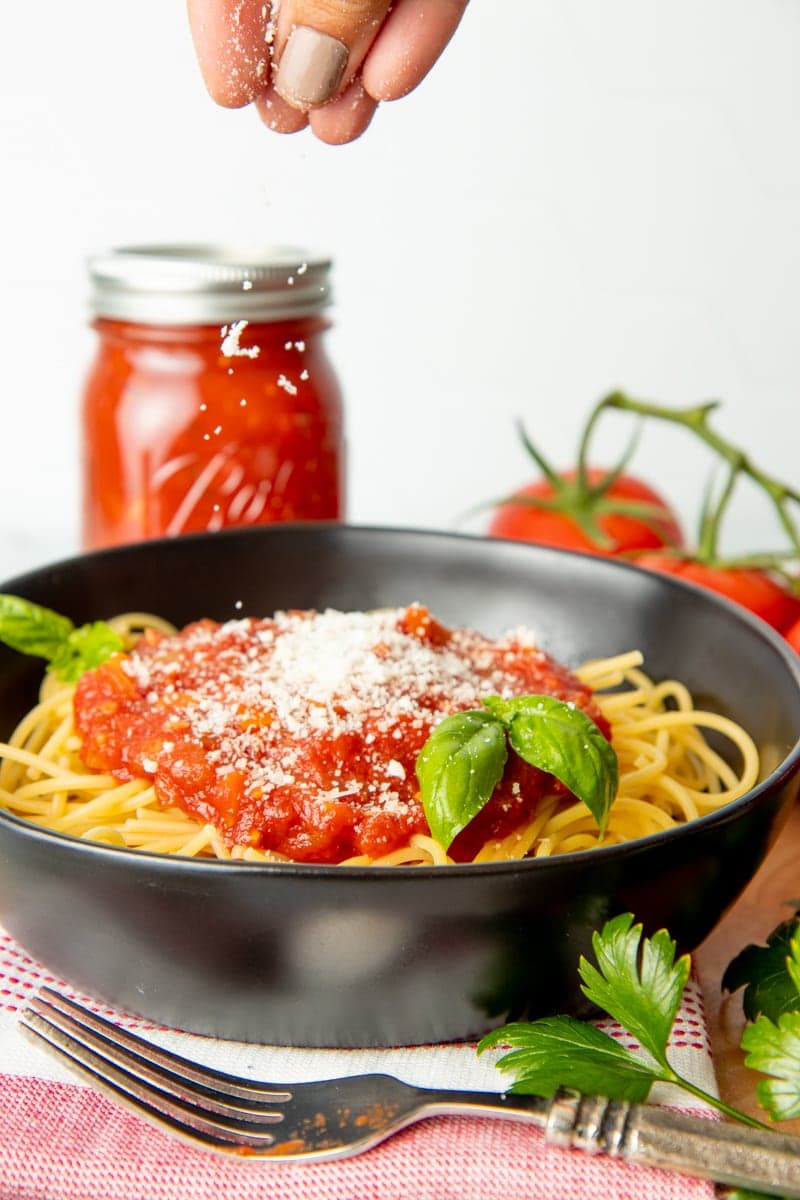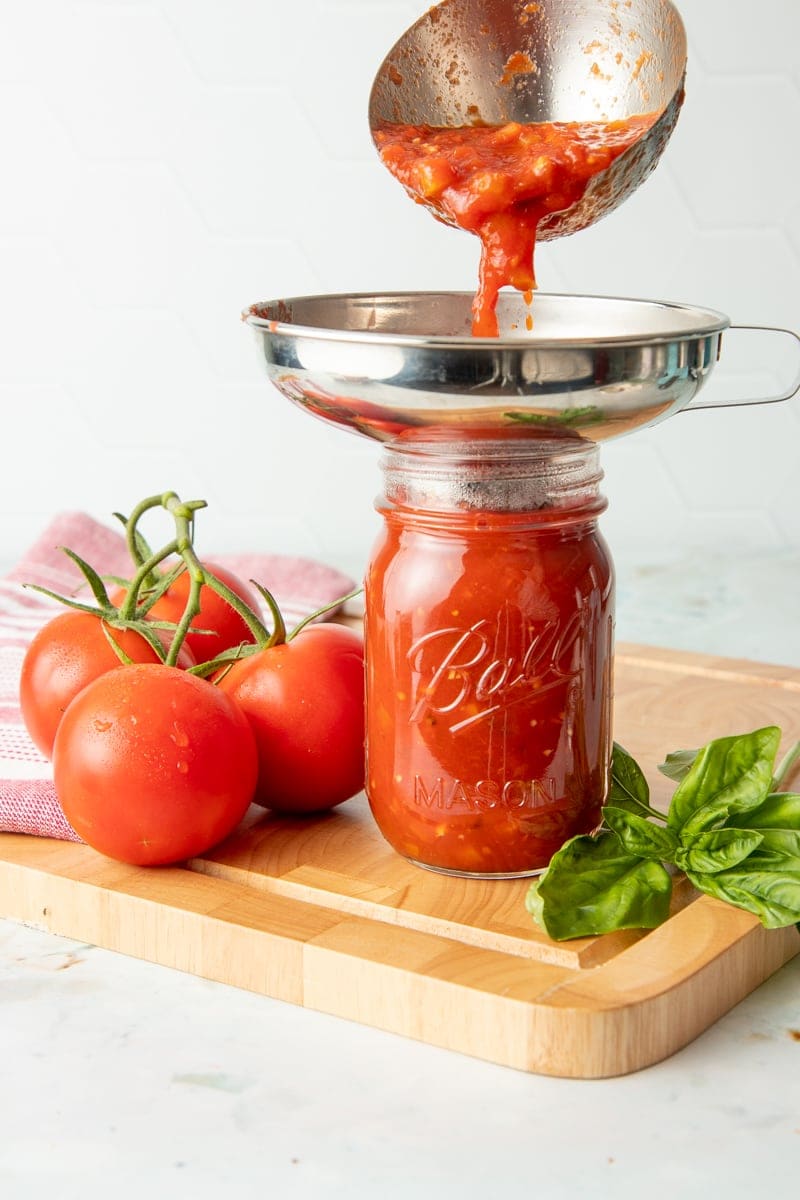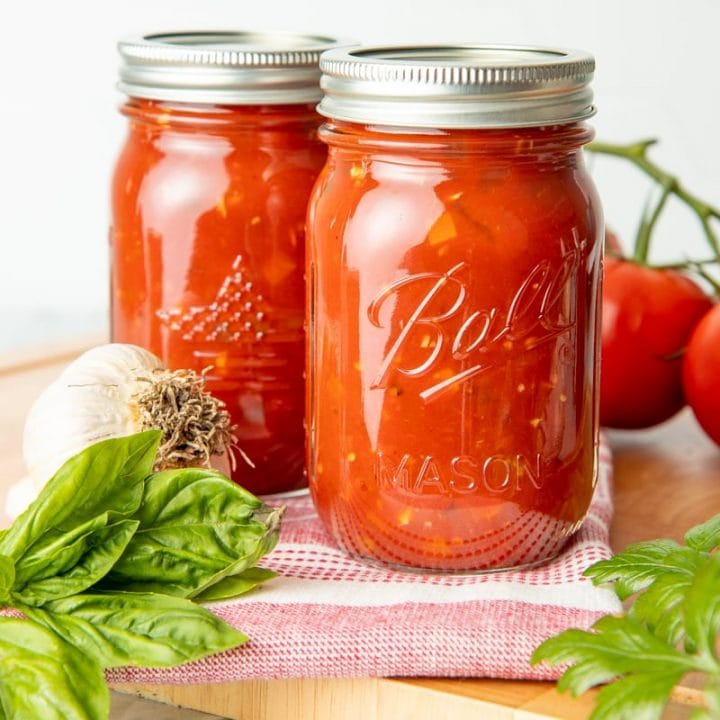It’s hard to beat boiling a pot of pasta and popping open a jar of spaghetti sauce for a speedy weeknight dinner that everyone in the family will love.
Sure, you can buy store-bought sauce, but why not get the best flavor out of homegrown summer tomatoes and can your own spaghetti sauce instead? We’re excited to be partnering with the makers of Ball® home canning products to bring you a beginner-friendly, Italian-style tomato sauce recipe you’ll love!

The great thing about this spaghetti sauce recipe is that it’s designed and tested to be processed in a water-bath canner! While certain canning spaghetti sauce recipes need to be processed in a pressure canner because of their low acid levels, this recipe has been lab-tested to be water bath canner safe, making this a perfect recipe for beginner canners. Let’s make some sauce!

What is the difference between marinara and spaghetti sauce?
This recipe is for an Italian-style tomato sauce—it’s not a traditional marinara sauce, although the two recipes are quite similar. In fact, many people use the two terms interchangeably.
While tomato sauces can vary quite a bit from region to region, in general:
- Marinara sauce is a thinner tomato-based sauce with simple aromatic veggies like onions and herbs.
- Spaghetti sauce (AKA: Italian-style tomato sauce) is typically a thicker and richer tomato-based sauce. Some recipes have a more complex herb and aromatic veggie profile than classic marinara sauce.

The phrase “spaghetti sauce” is a bit of a misnomer, because any sauce you use on spaghetti (alfredo, garlic sauce, etc.) can be considered a “spaghetti sauce.” Here in the US, though, most folks think of the thick, red, tomato-based sauce when they say “spaghetti sauce,” so we’re going with it!

Does spaghetti sauce need to be pressure canned?
Foods with a pH (AKA: acid level) of less than 4.6 are safe for water-bath canning. The high acid level doesn’t allow for the growth of microorganisms like botulism and other bacteria.
With a pH of between 4.3 and 5.0 (depending on growing conditions, variety, and other factors), tomatoes fall right on the line of needing to be pressure canned.

No need to buy a pressure canner though! We make this tomato sauce safe to water bath can by acidifying the sauce with lemon juice. This takes the pH level to a safe range and makes this a simple canning recipe that is great for beginners.
Wholefully Protip
Make sure to use bottled lemon juice for acidifying in all canning recipes. Why? Well, the pH level of bottled lemon juice is consistent—in fact, it’s regulated by the FDA—so you can ensure consistent acidifying. This isn’t true with fresh lemons, which can have a wide range of acid levels based on variety, growing conditions, and other factors.
Canned Spaghetti Sauce Ingredients
Because this is a tested recipe that is safe for water-bath canning, it is vital not to alter the type of ingredients or the amounts here to keep the pH level consistent. Here’s what you’ll need for each batch of sauce:
- Fresh tomato puree—We recommend using the very best paste tomatoes you can find. San Marzano-style tomatoes are our favorite. You can make the tomatoes into a puree by following the steps in this Homemade Tomato Sauce recipe.
- Onion, celery, carrot, and garlic cloves—These aromatic veggies give tons of flavor while being used in amounts that don’t impact the acid level of the sauce.
- Bottled lemon juice—Like we talked about above, bottled lemon juice will give consistent acidifying results to make this recipe safe for water-bath canning.
- Salt, pepper, and hot pepper flakes.
Wholefully Protip
This recipe leaves out the classic spaghetti sauce herbs like oregano, parsley, and basil to keep the acid level safe for water-bath canning. Also, herbs sometimes can become bitter when cooked at high heat. We recommend adding a handful of fresh or dried herbs (this is a great use for herb cubes!) and a drizzle of olive oil when reheating before serving.

Steps to Making Canned Spaghetti Sauce
Make sure you’ve got all your tools and ingredients ready when you begin canning spaghetti sauce (check our Canning 101 article for more info). When you’re ready to start canning, here’s how:

- Make your tomato puree following the steps in this Homemade Tomato Sauce Recipe.
- Prepare your boiling water canner, jars, and lids (per our Canning 101 guide).
- Combine a cup of tomato purée, onion, celery, carrot, and garlic in a large pot. Bring to a boil, then reduce heat, cover, and boil gently until vegetables are tender.
- Add remaining tomato purée, lemon juice, salt, black pepper, and hot pepper flakes. Bring to a boil, and simmer until mixture is reduced by one-third.
- Ladle sauce into jars, leaving proper headspace of 1/2-inch. Remove air bubbles.
- Wipe rim of the jar and then place lid and ring on jar, tightening just until it’s fingertip tight.
- Process filled jars in a boiling water canner for 35 minutes. Remove jars and cool.
- Check lids for seal. Lid should not flex up and down when center is pressed.
Wholefully Protip
We used Ball® Regular Mouth Stars & Stripes Keepsake Pint Jars for this recipe, but any Ball® Pint Jar will do the trick!

Do you have to add lemon juice when canning spaghetti sauce?
Yes. Adding lemon juice makes this tomato sauce safe to water-bath can. This takes the pH level to a safe range.
But wait, doesn’t adding lemon juice make it taste super acidic?
Nope, and that’s thanks to the carrots in the recipe! They cook down and add a wonderful sweetness to the sauce that balances out the flavor of the added acid.

What kind of salt do you use when canning tomatoes?
Any kind of salt works for canning tomato sauce. Unlike canning pickles, where you need to use a special kind of salt without additives to achieve a clear brine, any salt you regularly use in your kitchen will work in this recipe.
How do you keep homemade tomato sauce from separating?
No worries about the sauce separating in the jar—it’s perfectly safe to enjoy even if it has separated. Just give the jar a good shake before using.
Wholefully Protip
When reheating your sauce, if it seems like it’s separating, you can whisk in 1/2 teaspoon of xanthan gum per pint of sauce to stabilize the sauce before serving. A small slurry of cornstarch (3 tablespoons water whisked with 2 teaspoons cornstarch) will also work in place of the xanthan gum.

How long does canned spaghetti sauce last?
Properly sealed preserves are best used within 18 months. However, as long as the jar still has a good seal, canned goods can be stored almost indefinitely. The quality of the food might decrease (you might lose flavor, color, or texture), but it will still be safe to eat.

Can I use this spaghetti sauce fresh instead of canning it?
Absolutely! This sauce is delicious ladled right out of the pot it’s been simmering in. In fact, we tend to make sure spaghetti is on the menu on days when we’re canning spaghetti sauce—we grab a few scoops for dinner and the rest goes into jars for long-term preservation.
How can I use canned spaghetti sauce?
You’ll find that having a pantry full of spaghetti sauce is incredibly handy! You can, of course, toss your sauce with some hot spaghetti for a wonderful, simple dinner, but you can also use your homemade spaghetti sauce in these dishes:
- Use your spaghetti sauce to make our easy Penne Rosa recipe!
- Slather our Vegan Meatballs with your homemade spaghetti sauce for an awesome meatless meal.
- Looking for an easy lasagna recipe? Lasagna Rosa is a winner that is family-friendly!
- Use your tomato sauce on our Almond Flour Pizza Crust for a killer gluten-free pizza.
- Drizzle canned spaghetti sauce on top of our Vegan Stuffed Shells for a plant-based dish that is fancy enough for guests
- Pour a big puddle of spaghetti sauce to dip bites from our Turkey Florentine Calzones in!
- Use this sauce inside our Homemade Pizza Rolls—a kid-favorite in our house!

Canned Spaghetti Sauce (AKA: Italian-Style Tomato Sauce)
Homemade spaghetti sauce is not out of your reach, and it tastes so much better than the stuff from the store! These simple steps will guide you to canning success.
Recipe courtesy of Ball® Home Canning Fresh Preserving.
Ingredients
- 8 cups fresh plum tomato purée
- 2/3 cup finely chopped onion
- 2/3 cup finely chopped celery
- 1/2 cup finely chopped carrot
- 2 cloves garlic, finely chopped
- 4 tbsp bottled lemon juice
- 2 tsp salt
- 1/2 tsp freshly ground black pepper
- 1/2 tsp hot pepper flakes
- 3 Ball® (16 oz) pint glass preserving jars with lids and bands
- Optional: Ball® freshTECH Electric Water Bath Canner + Multicooker
Instructions
- Prepare boiling water canner. Heat jars in simmering water until ready for use. Do not boil. Wash lids in warm soapy water and set bands aside.
- Combine 1 cup of tomato purée, onion, celery, carrot and garlic in a large stainless steel saucepan. Bring to a boil over medium-high heat, stirring frequently. Reduce heat, cover and boil gently until vegetables are tender, about 5 minutes. While maintaining a steady boil, add remaining tomato purée, 1 cup at a time, stirring frequently. Stir in lemon juice, salt, black pepper and hot pepper flakes. Increase heat to high and bring to a full rolling boil; boil hard, stirring frequently, until mixture is reduced by one third, about 15 minutes.
- Ladle hot sauce into hot jars leaving 1/2 inch headspace. Remove air bubbles and re-measure headspace. If needed, add more sauce to meet recommended headspace. Wipe rim. Center lid on jar. Apply band and adjust until fit is fingertip tight.
- Process filled jars in a boiling water canner for 35 minutes, adjusting for altitude. Remove jars and cool. Check lids for seal after 24 hours. Lid should not flex up and down when center is pressed.
Nutrition Information:
Yield: 12 Serving Size: 1/2 cupAmount Per Serving: Calories: 75Total Fat: 0gSaturated Fat: 0gTrans Fat: 0gUnsaturated Fat: 0gCholesterol: 0mgSodium: 448mgCarbohydrates: 18gFiber: 4gSugar: 9gProtein: 3g
At Wholefully, we believe that good nutrition is about much more than just the numbers on the nutrition facts panel. Please use the above information as only a small part of what helps you decide what foods are nourishing for you.


